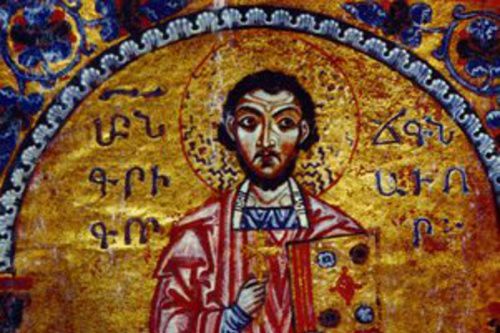St. Gregory of Narek — a tenth century priest, monk, mystic, and poet beloved among Armenian Christians — has become the first Armenian to be named a Doctor of the Church. “It is a great honor for the Armenian Church to contribute to this very important rank of saints who have enriched the Catholic Church with their teachings,” Armenian Catholic priest Father Thomas Garabedian told CNA Feb. 23. “Certainly this is a big honor for us Armenian-Americans,” said Fr. Garabedian, who is chancellor of the Armenian Catholic Eparchy of Canada and the United States. The Pope on Feb. 21 confirmed St. Gregory of Narek as the Church’s newest doctor during a private audience with Cardinal Angelo Amato, prefect for the Congregation for the Causes of Saints, Vatican Radio reports. St. Gregory of Narek is known for his various poetic writings, especially a book of prayers entitled “Book of Lamentations.” “This saint is very revered in the Armenian Church. It is not uncommon to find his book in every Armenian household throughout the Middle East and also here,” Fr. Garabedian continued. The saint’s book laments his nature as a great sinner, said the priest, who compared him to mystics like St. Teresa of Avila and St. John of the Cross. St. Gregory was born in the ancient Armenian region of Andzevatsik around the year 950, the son of an archbishop named Khosrov. His mother died when he was young, and he was educated by his cousin Anania, who founded the local monastery and school. Ordained a priest at 25, St. Gregory began his writing career with a commentary on the “Song of Songs.” He died in Narek in southeast Turkey around the year 1005. The monastery of Narekavank, where the saint passed most of his life, was destroyed in 1951. A mosque has since been erected in its place. St. Gregory of Narek is venerated as a saint both in the Catholic Church and the Armenian Apostolic Church, which is not in full communion with Rome. The Armenian Catholic Church, an Eastern Church in union with Rome, has about 1 million members. Armenians suffered one of the first genocides of the 20th century, beginning in 1915 under the Ottoman Empire and continuing under the Turkish government which succeeded it. Over 1 million people were killed and many displaced. Pope Francis particularly spoke about the martyrdom of Armenian Christians at a May 8, 2014 meeting with Patriarch Karekin II of the Armenian Apostolic Church. The Pope said the “ecumenism of suffering and of the martyrdom of blood are a powerful summons to walk the long path of reconciliation between the Churches, by courageously and decisively abandoning ourselves to the working of the Holy Spirit.” In a 2001 apostolic letter marking the 1,700th anniversary of Christianity in Armenia, St. John Paul II praised St. Gregory of Narek as one who “probed the dark depths of human desperation and glimpsed the blazing light of grace that shines even there for believers.” Before Saturday, there were 35 Doctors of the Church recognized for their universal importance to the Catholic Church due to their great learning and sanctity. In October 2012, Pope Benedict XVI named Sts. John of Avila and Hildegard von Bingen as Doctors of the Church.

